
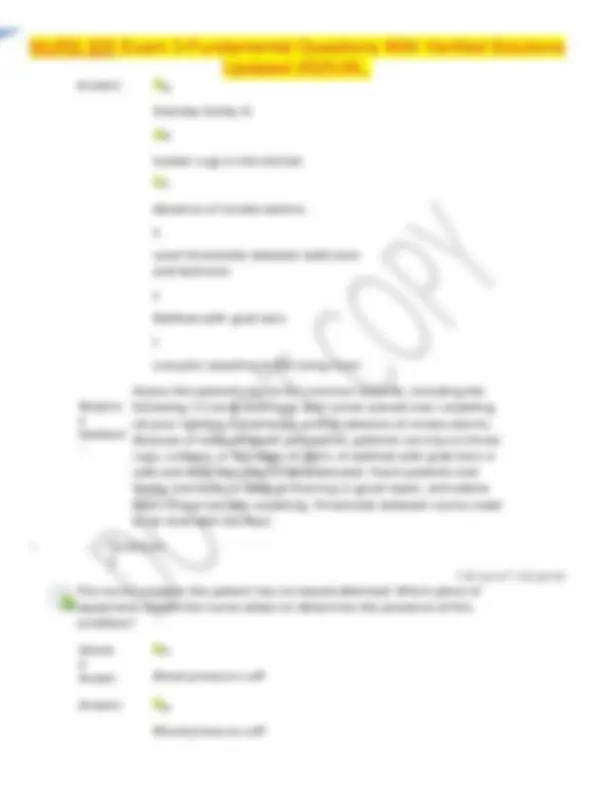

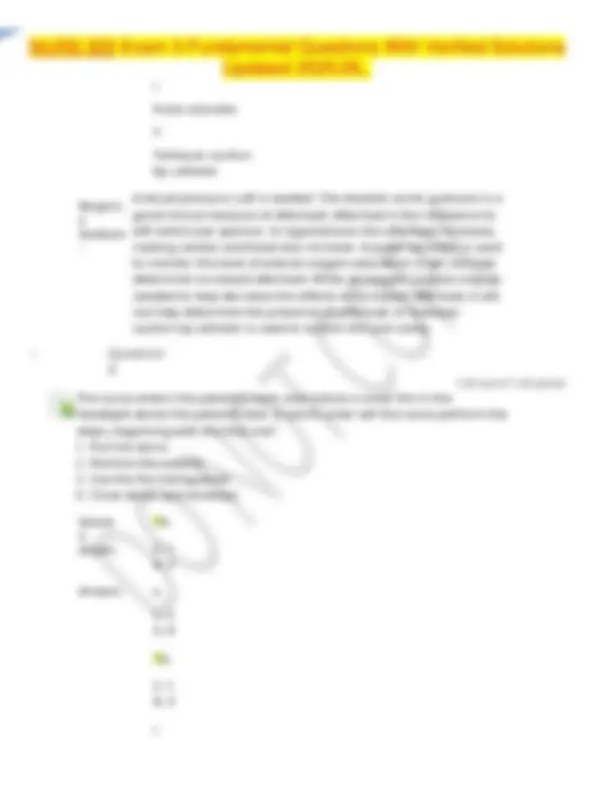

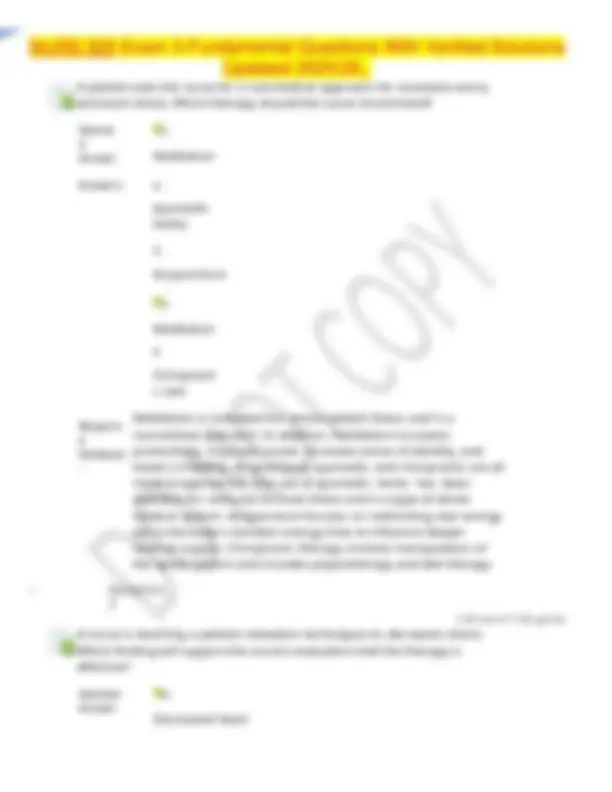

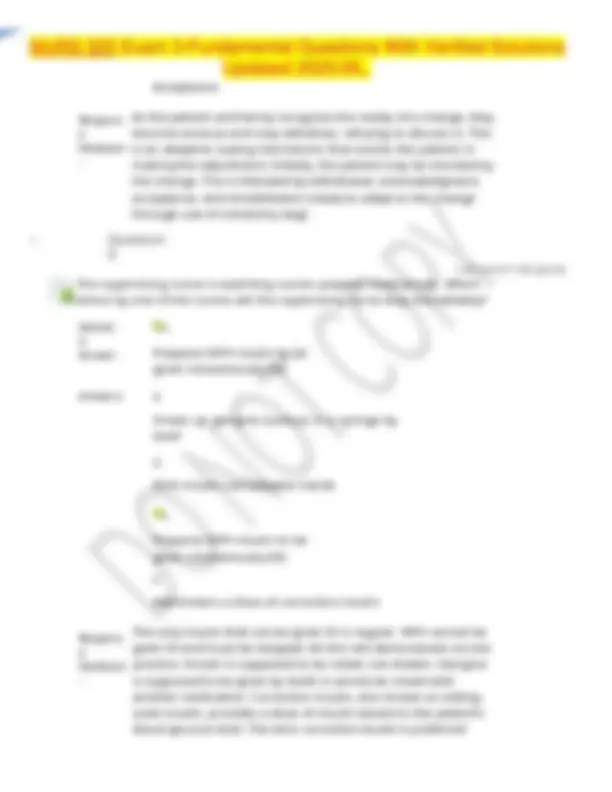

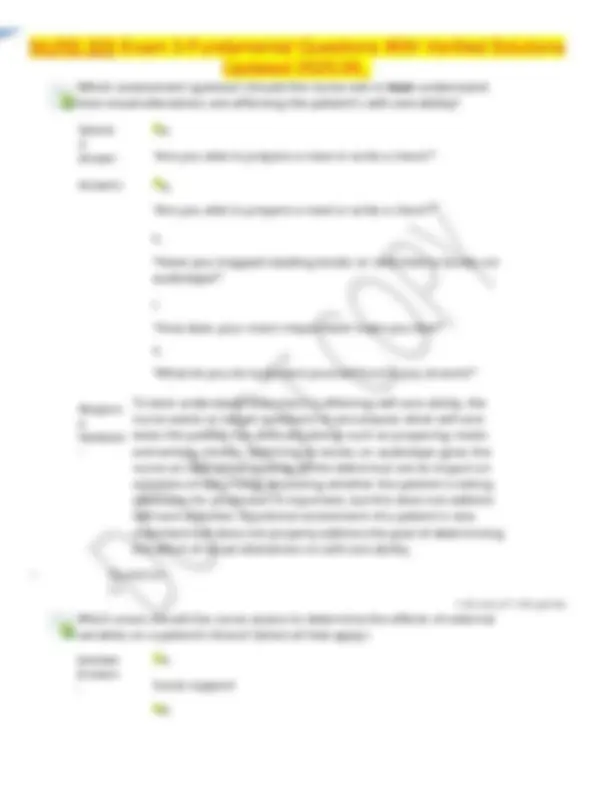

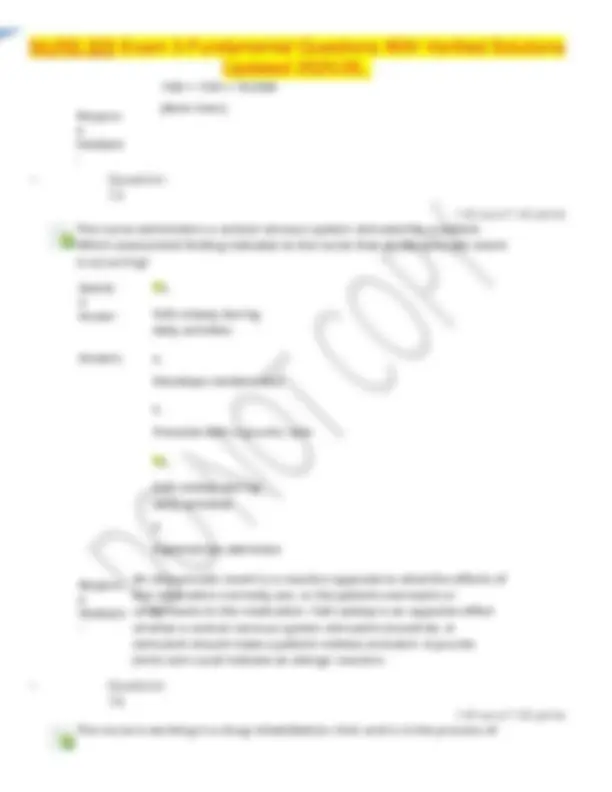

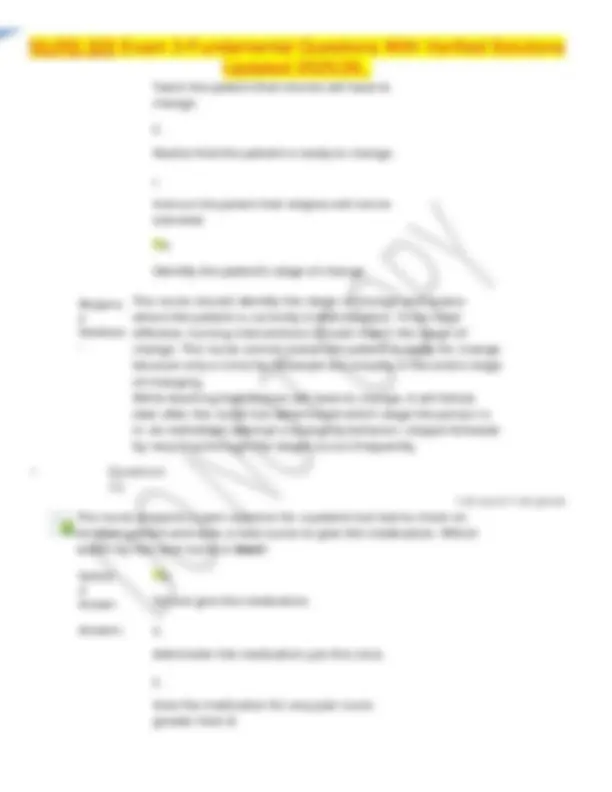

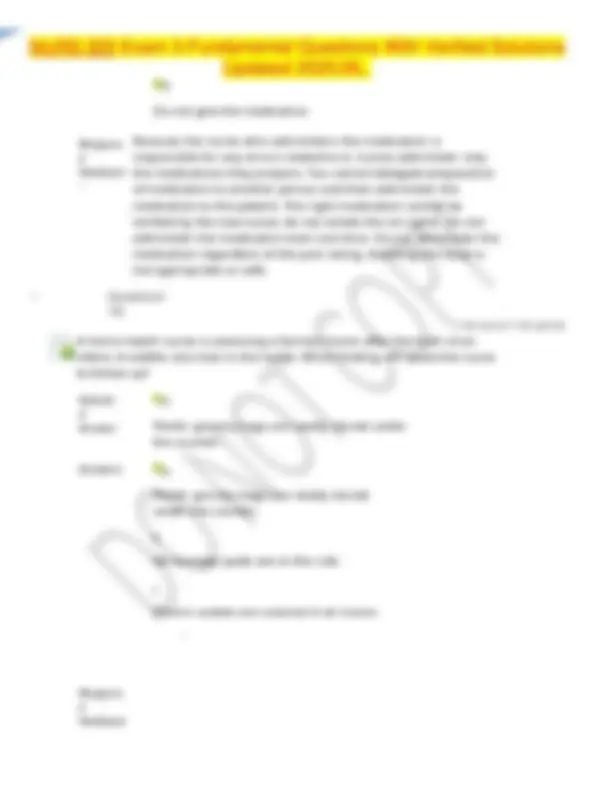
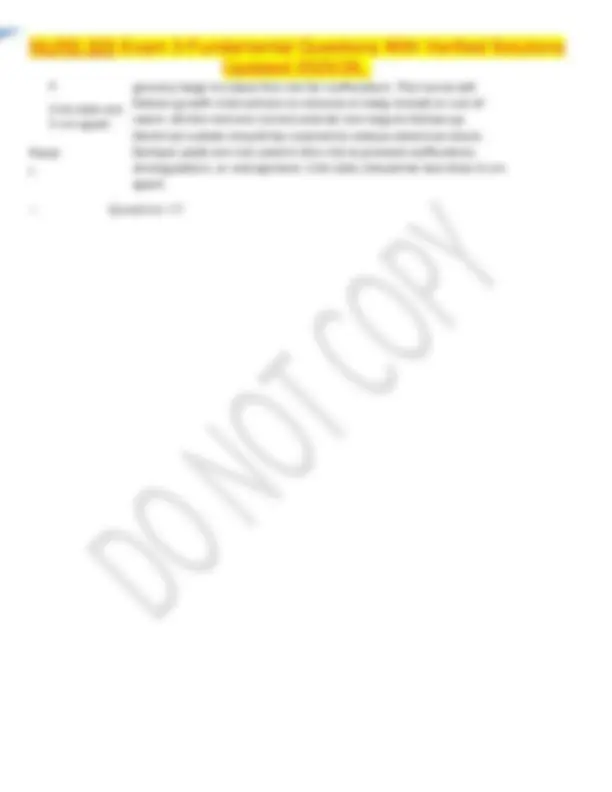
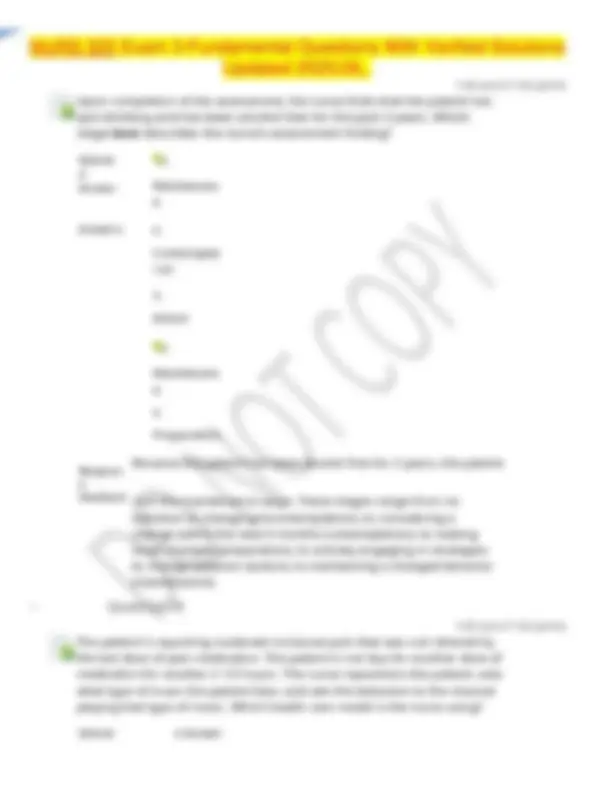

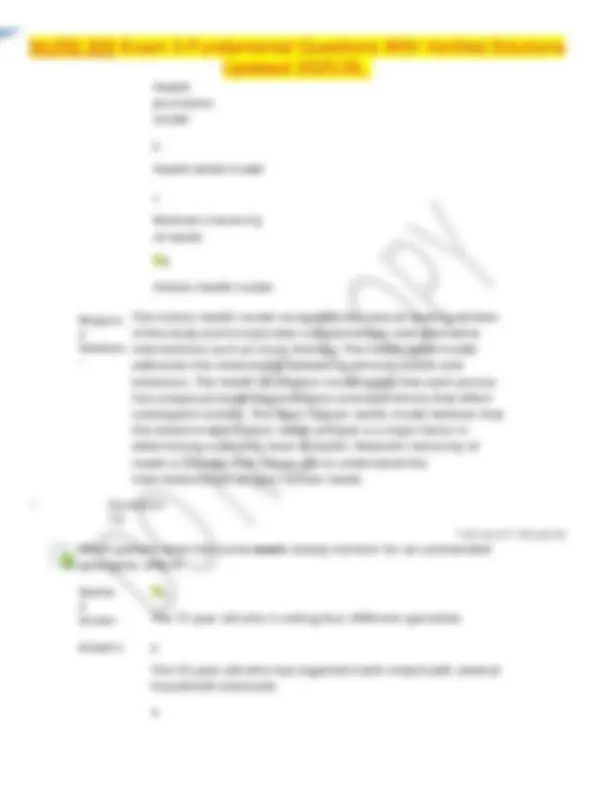

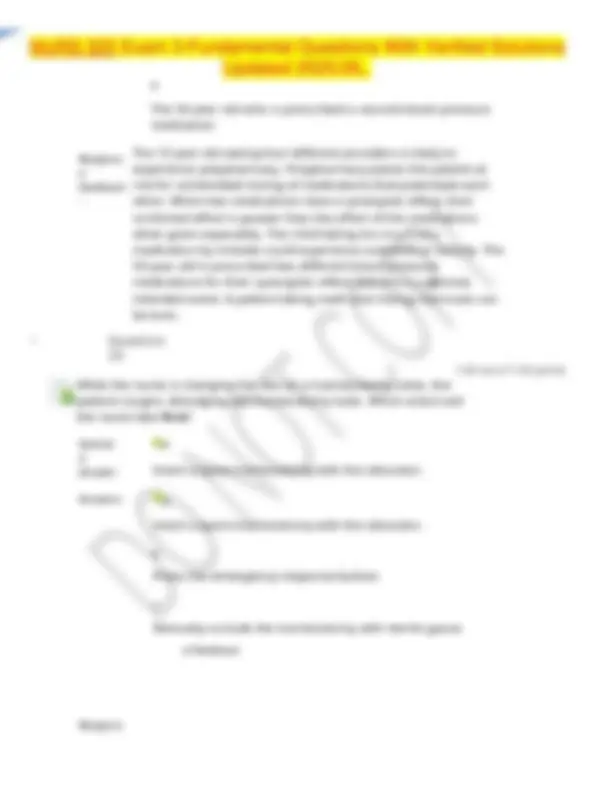
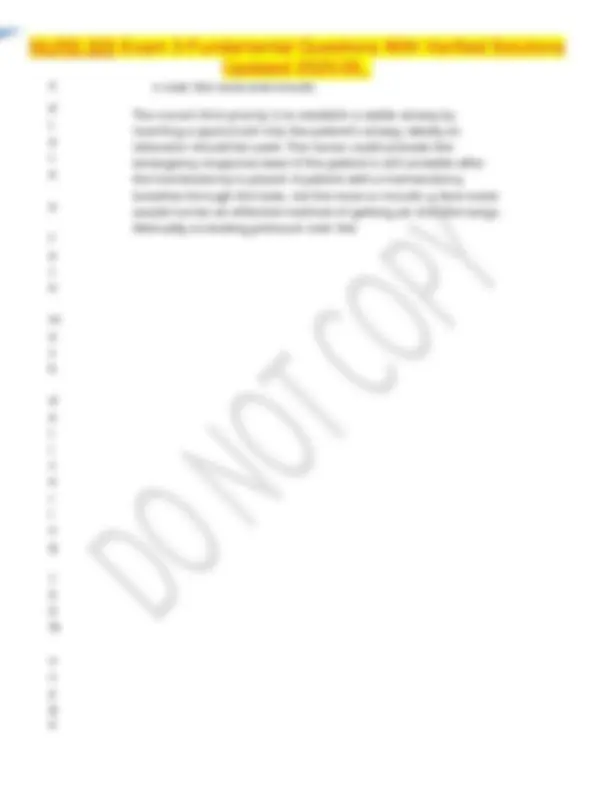
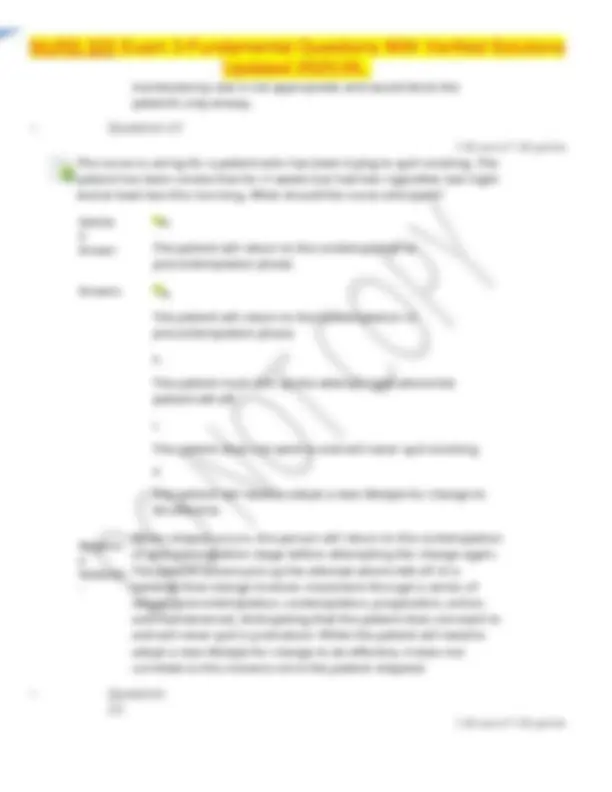

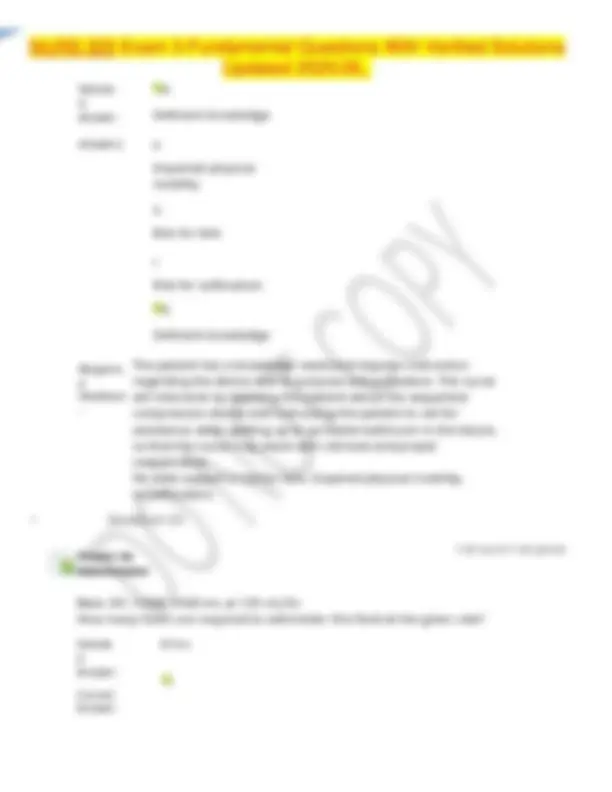
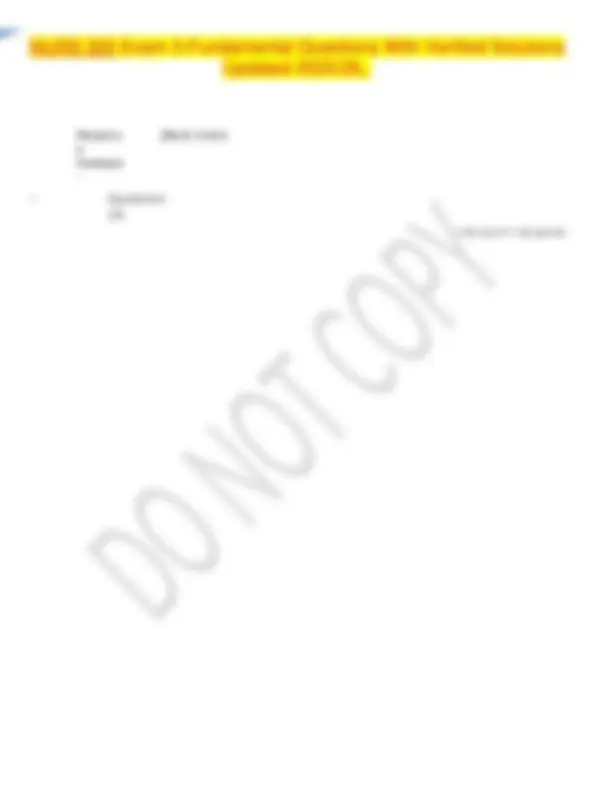
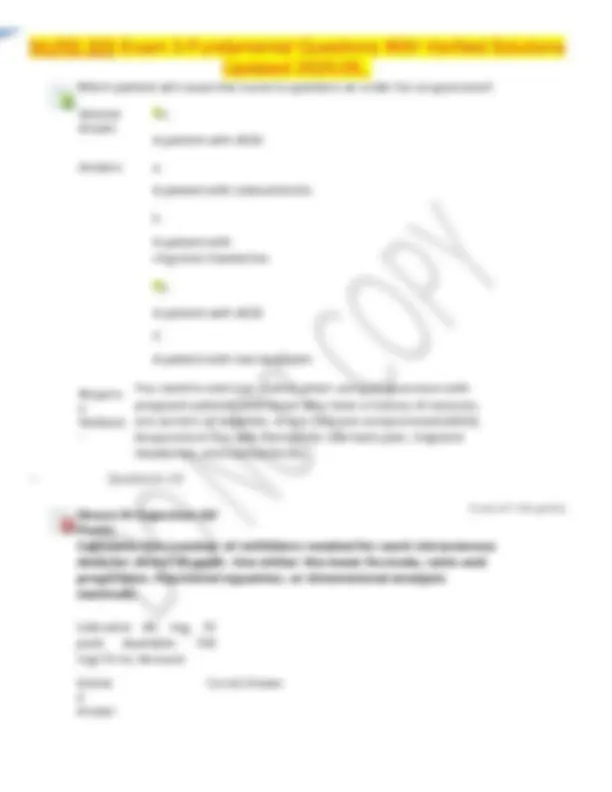

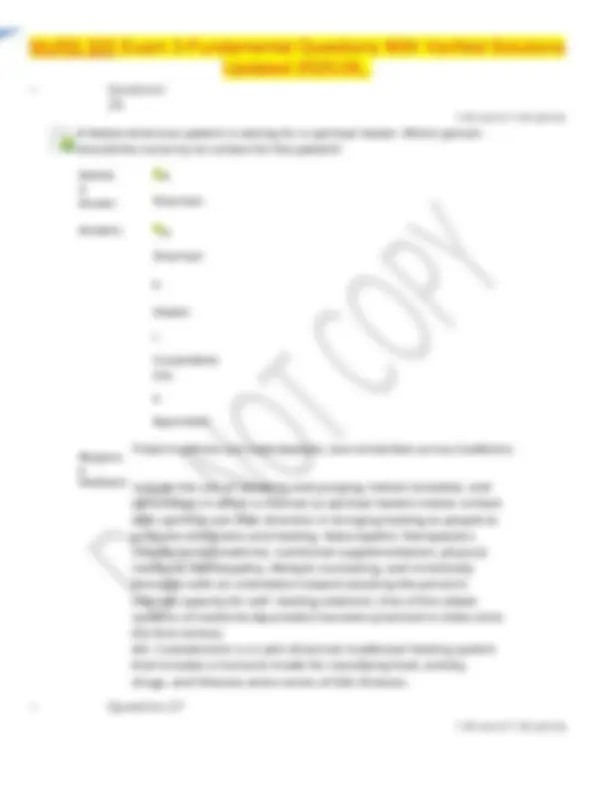

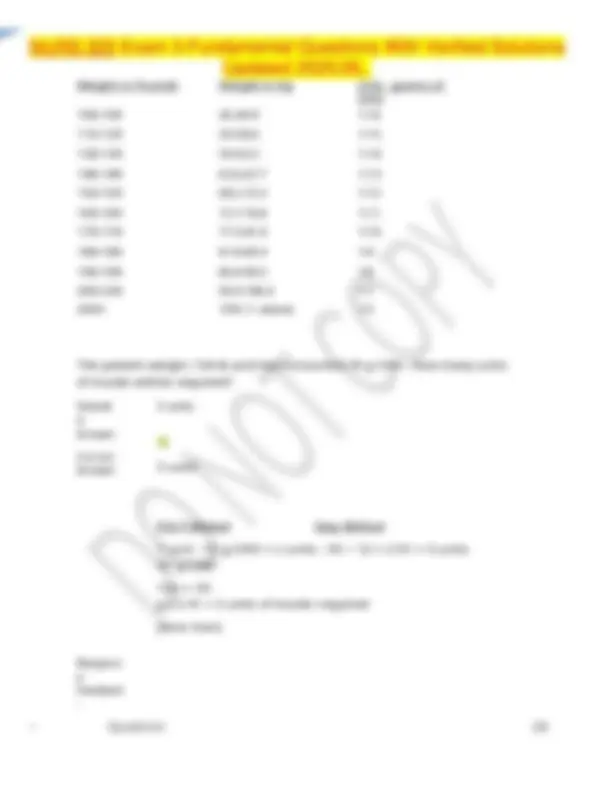

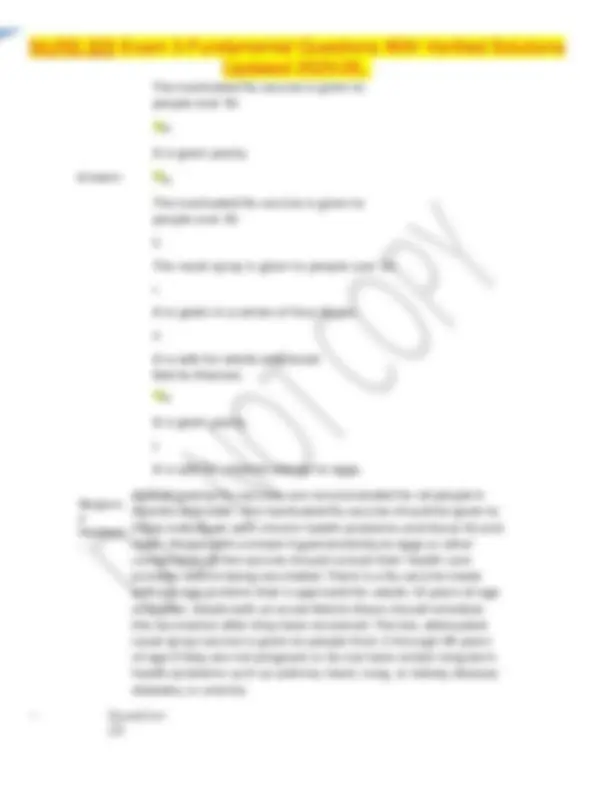

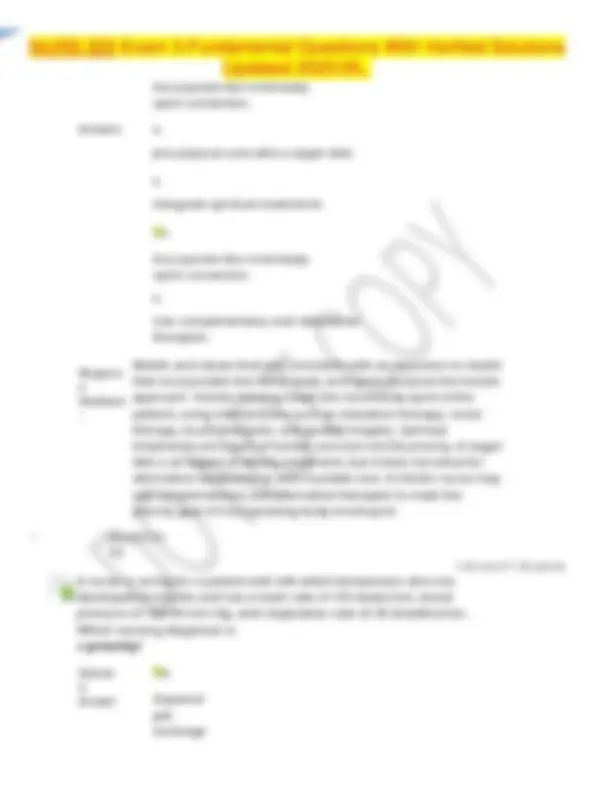

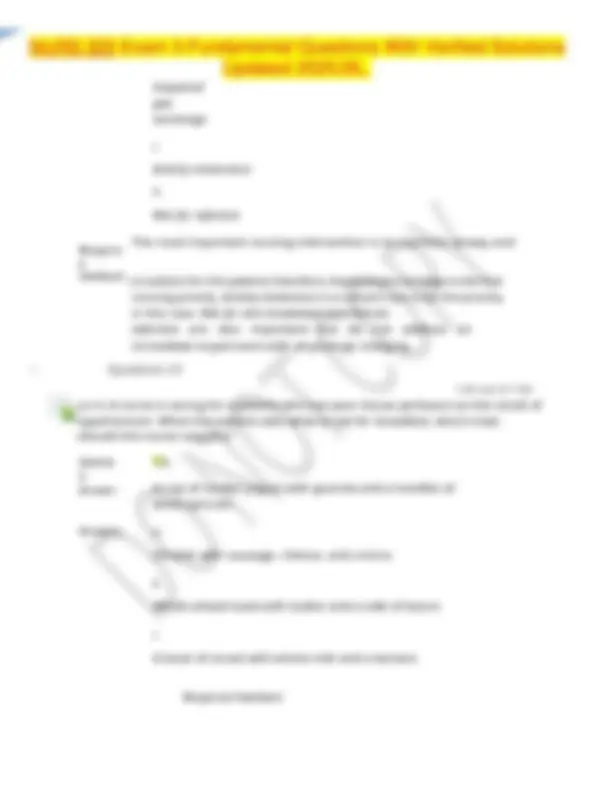
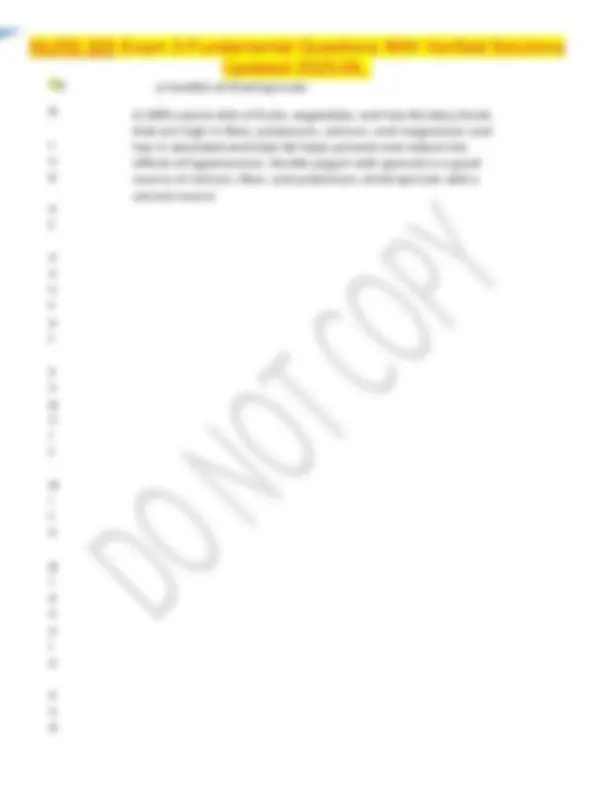
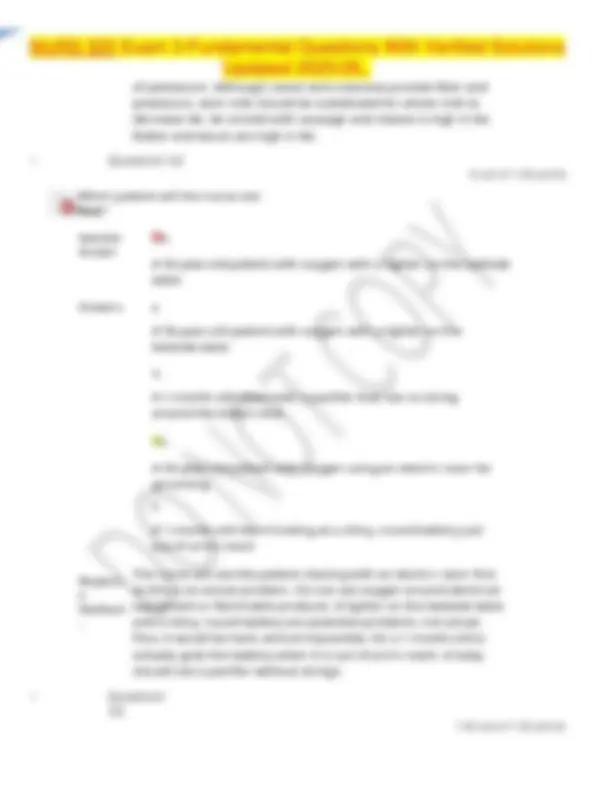



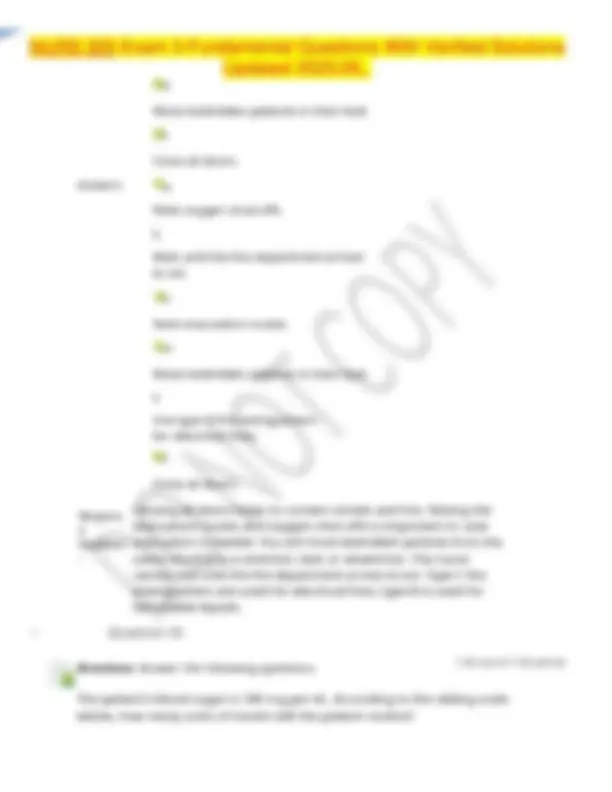

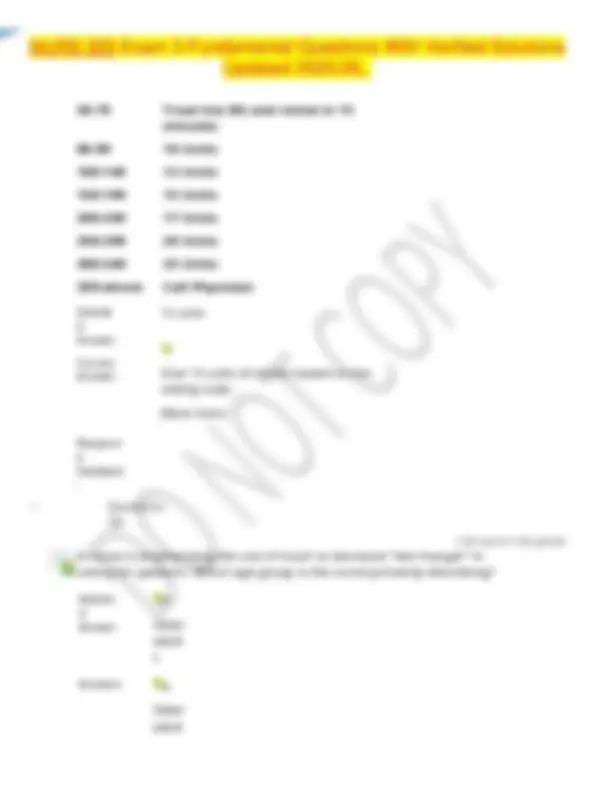

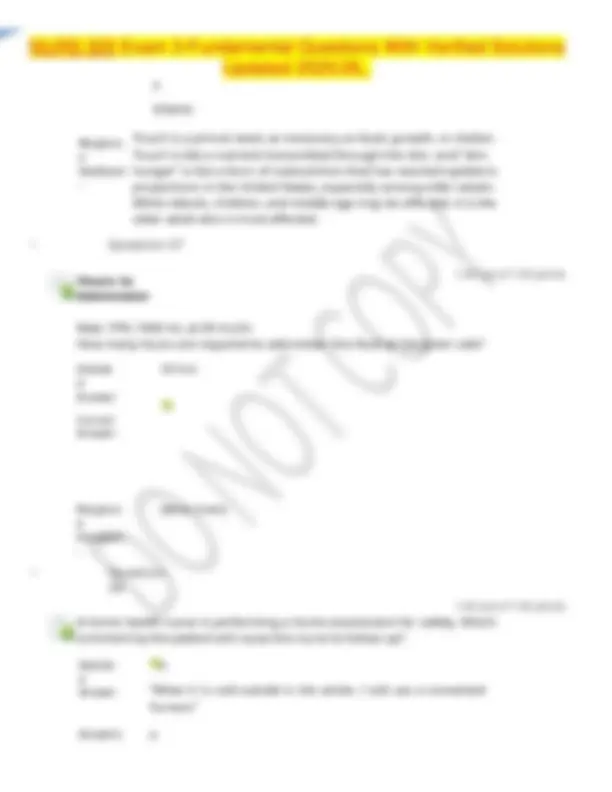

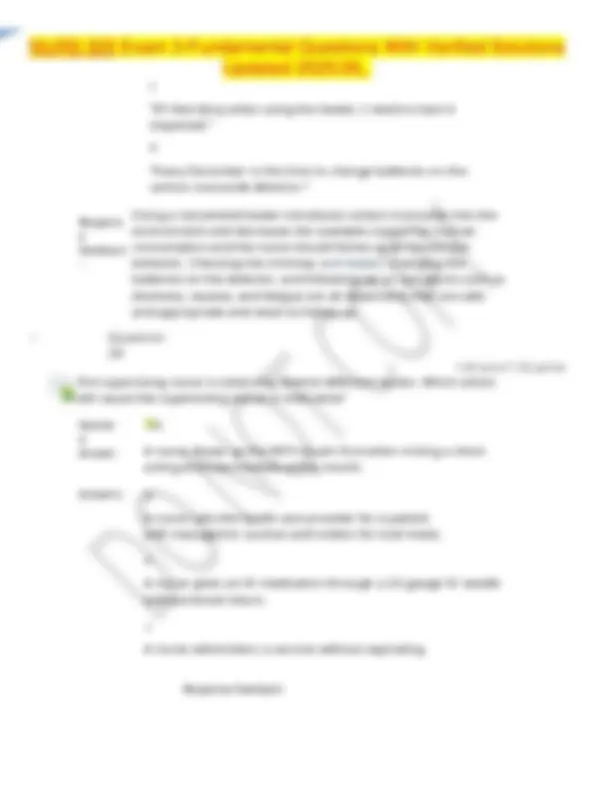

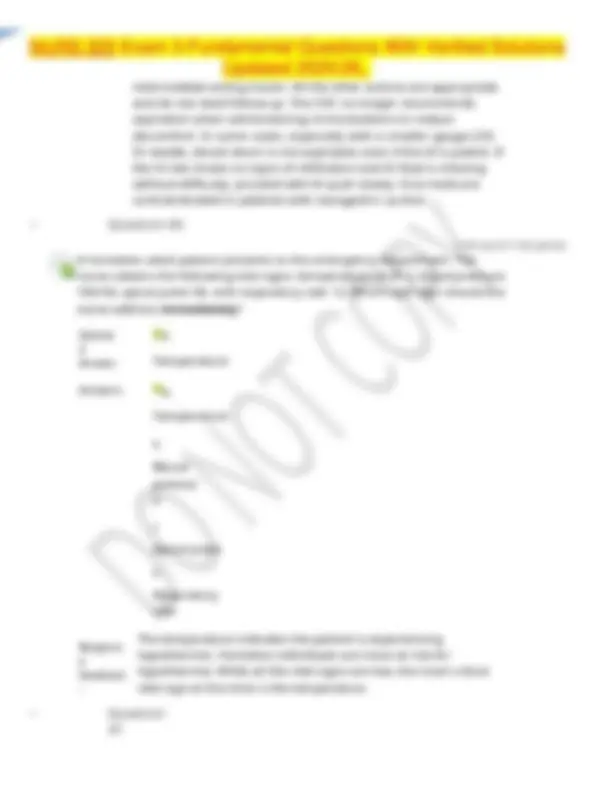

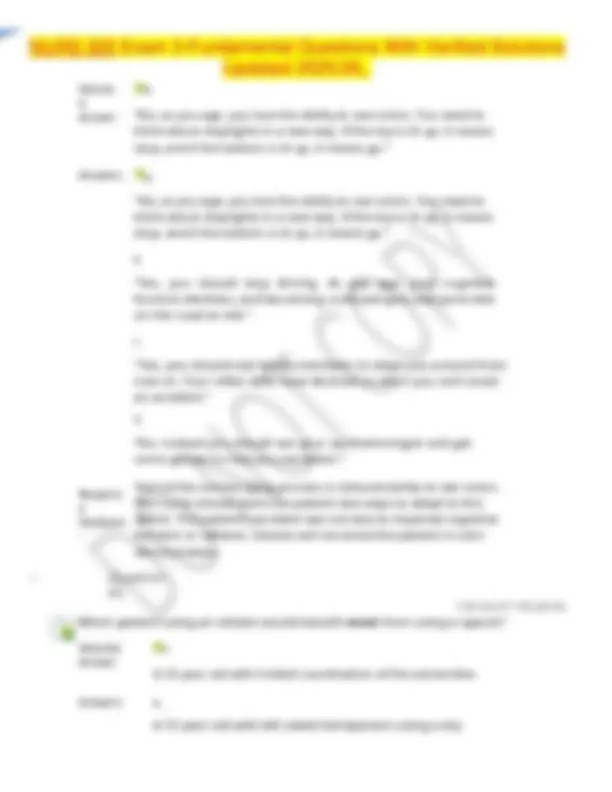

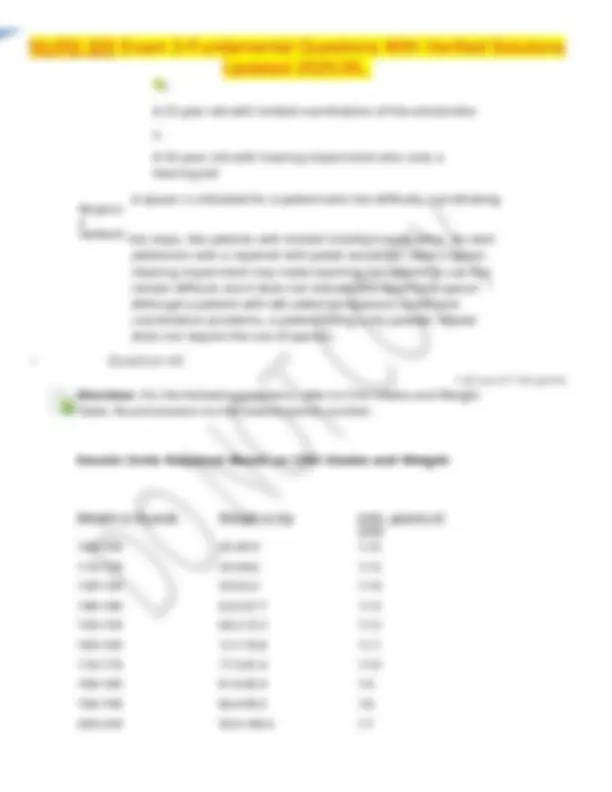

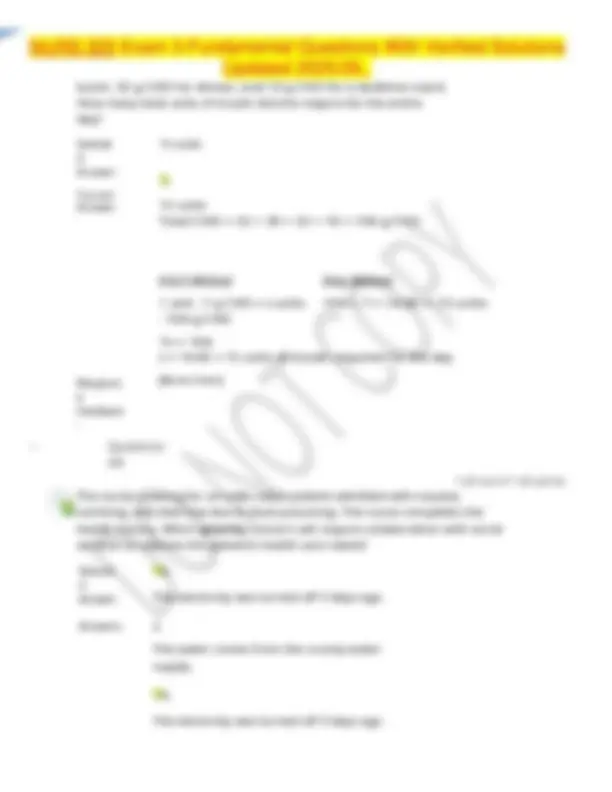
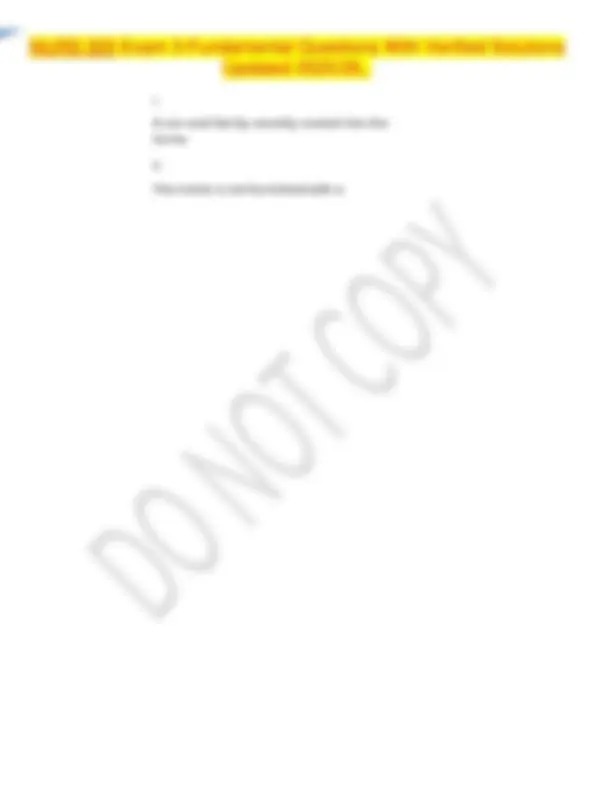
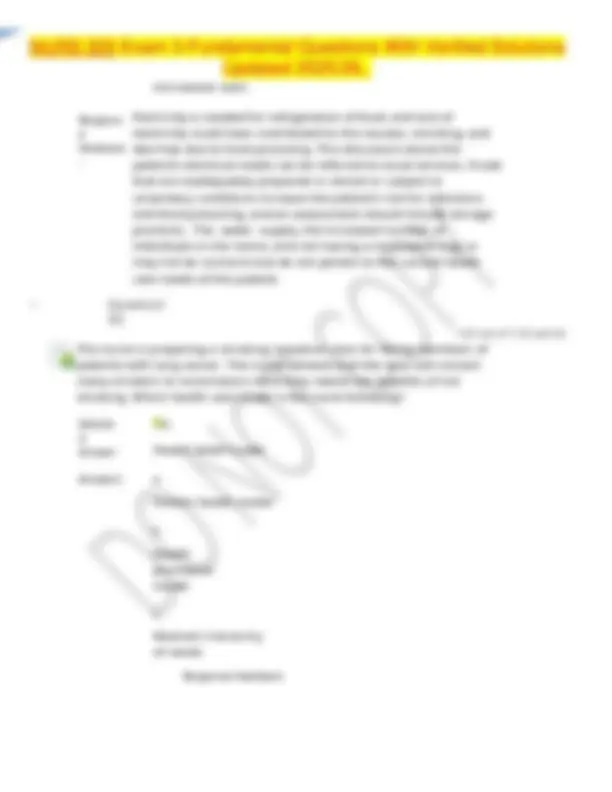



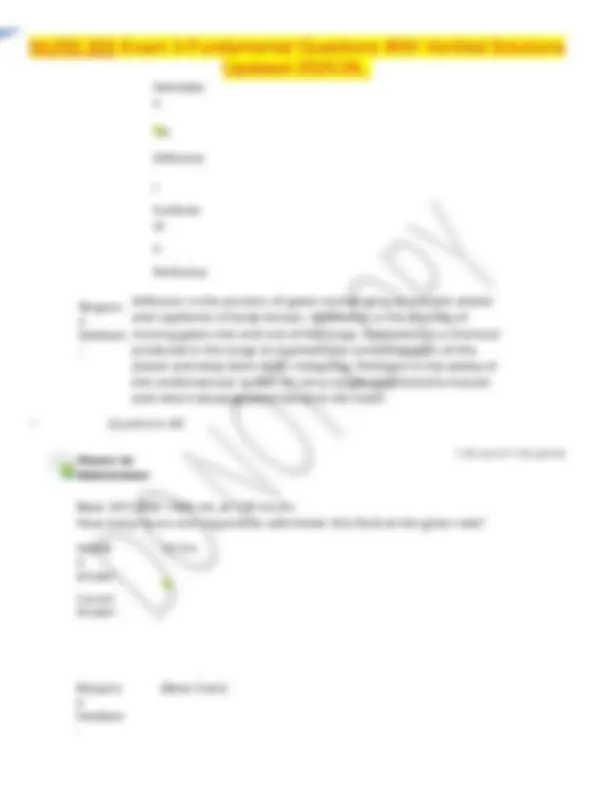

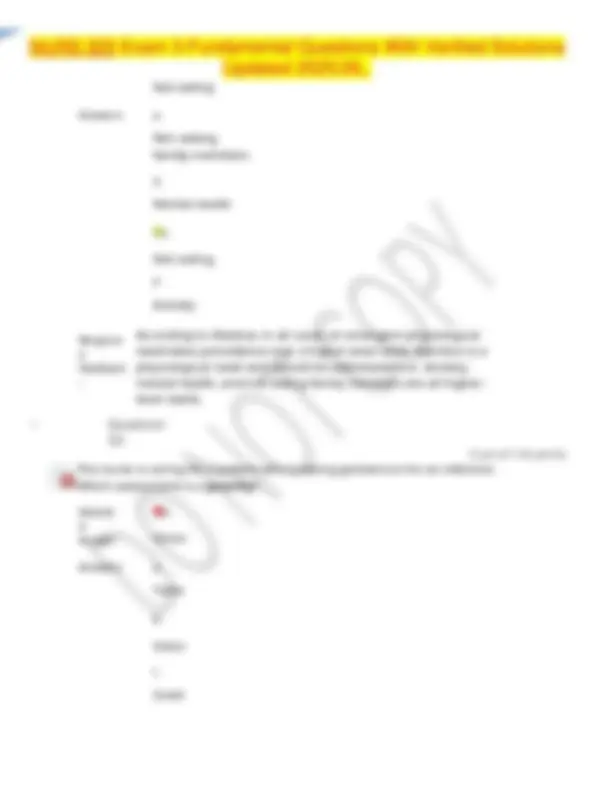

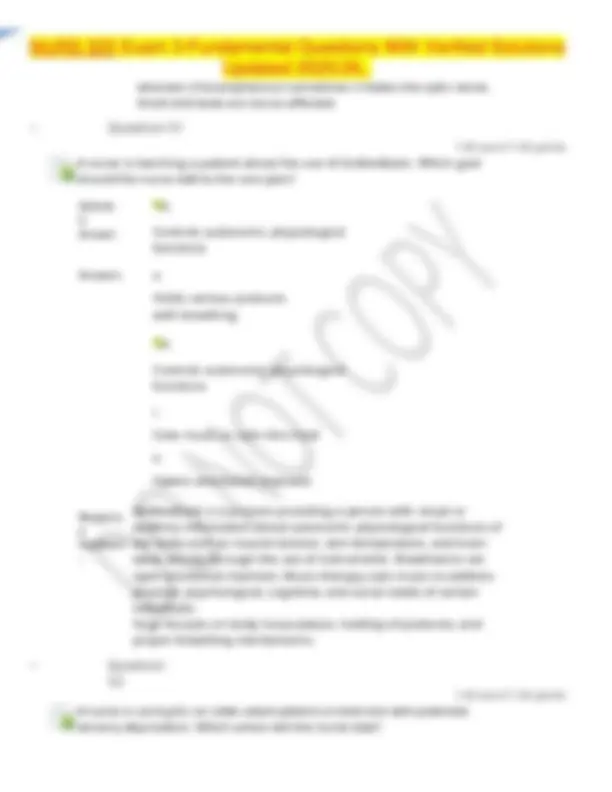

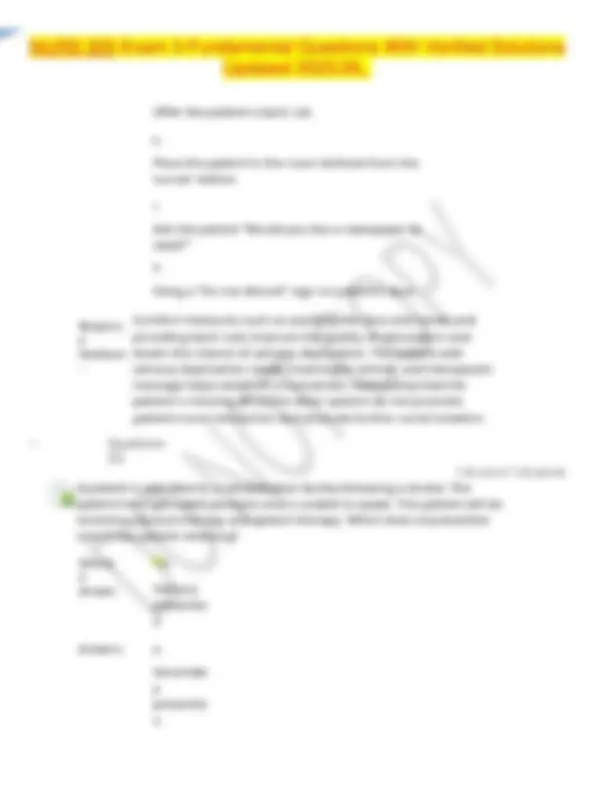

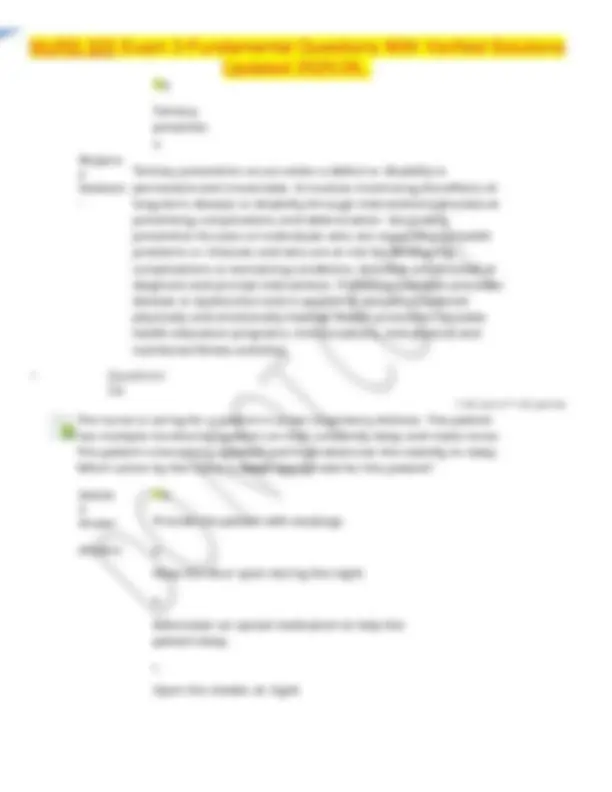
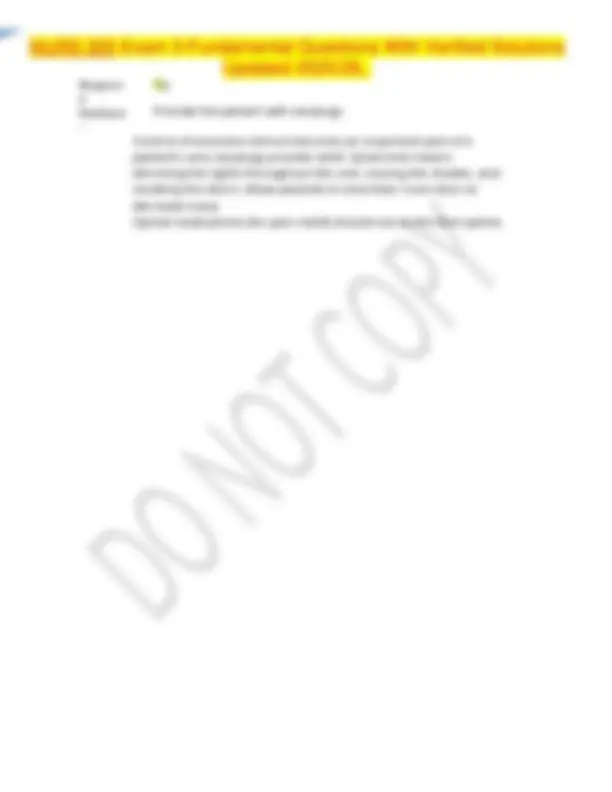
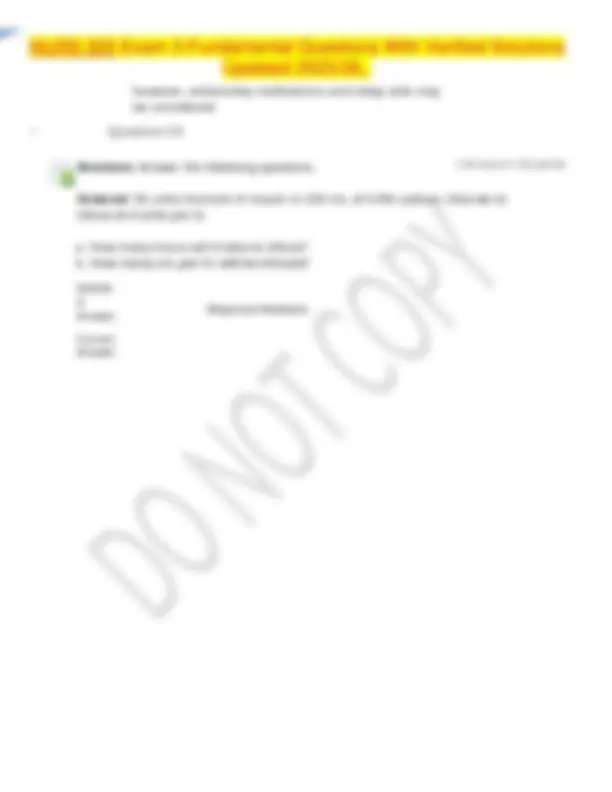
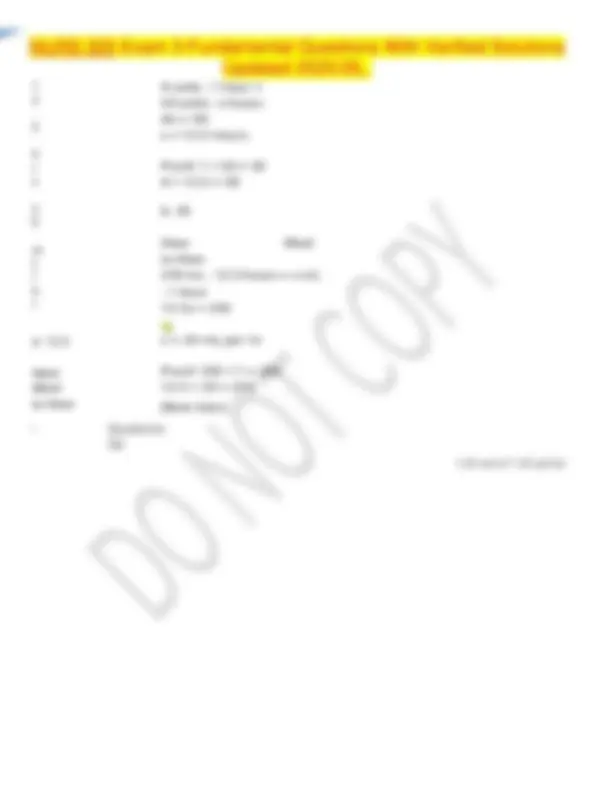


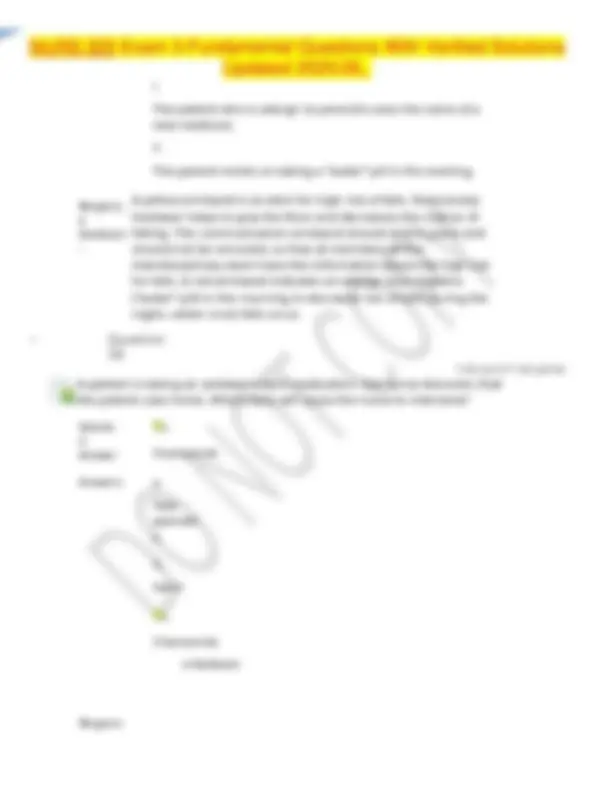

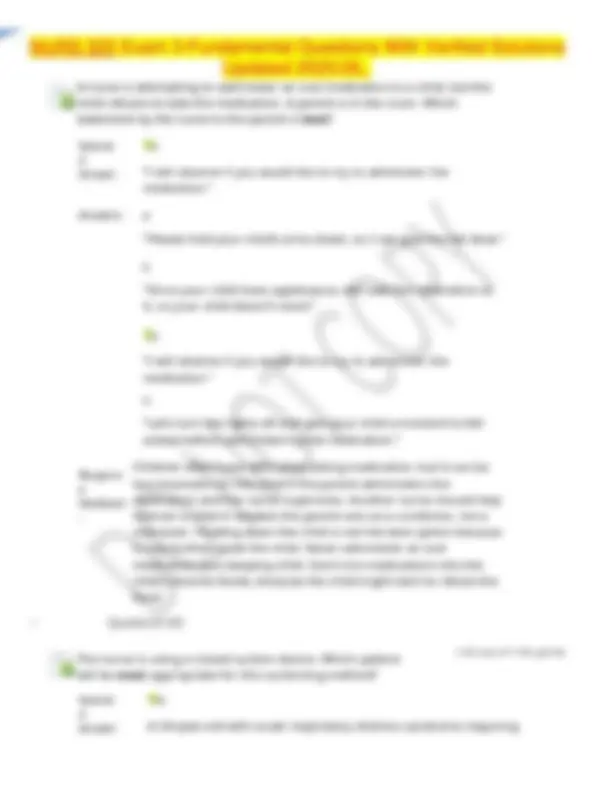

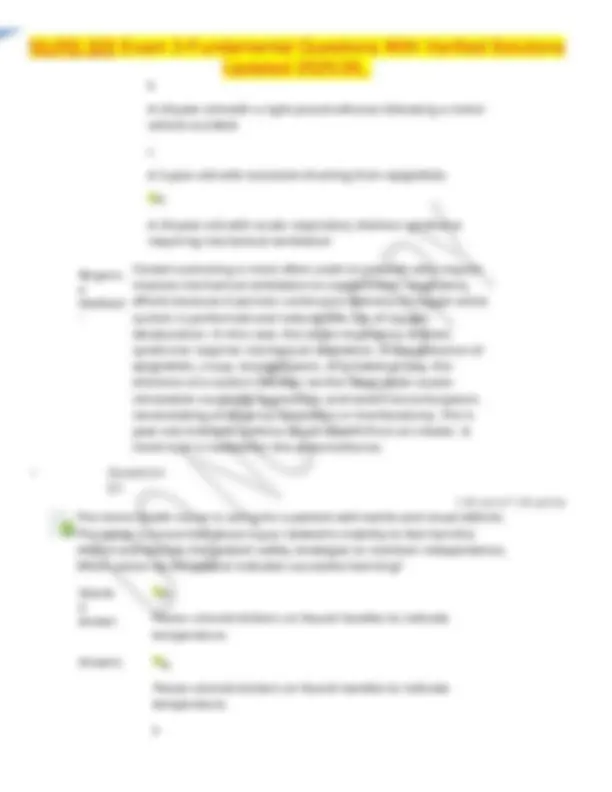

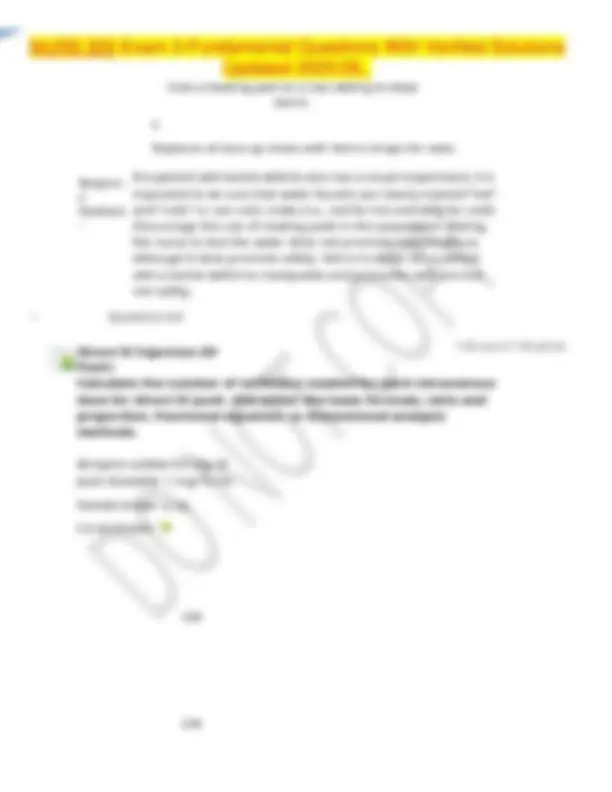



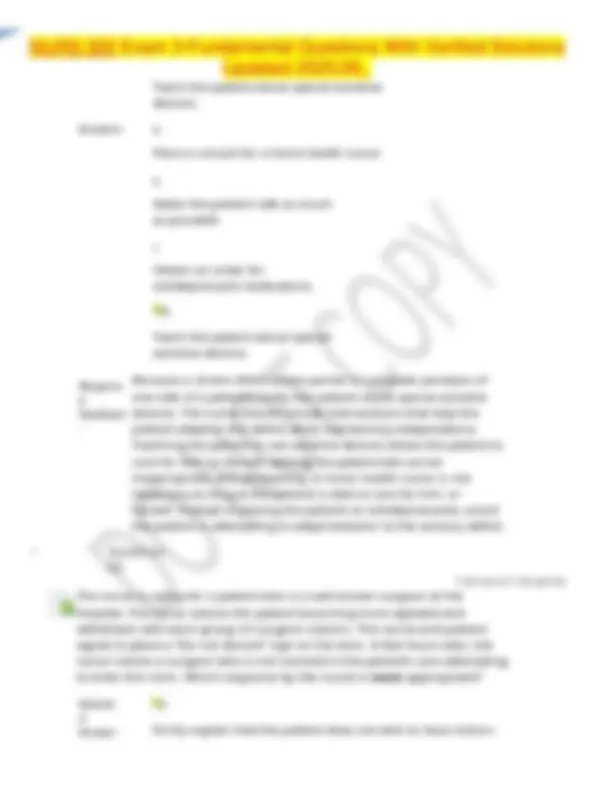

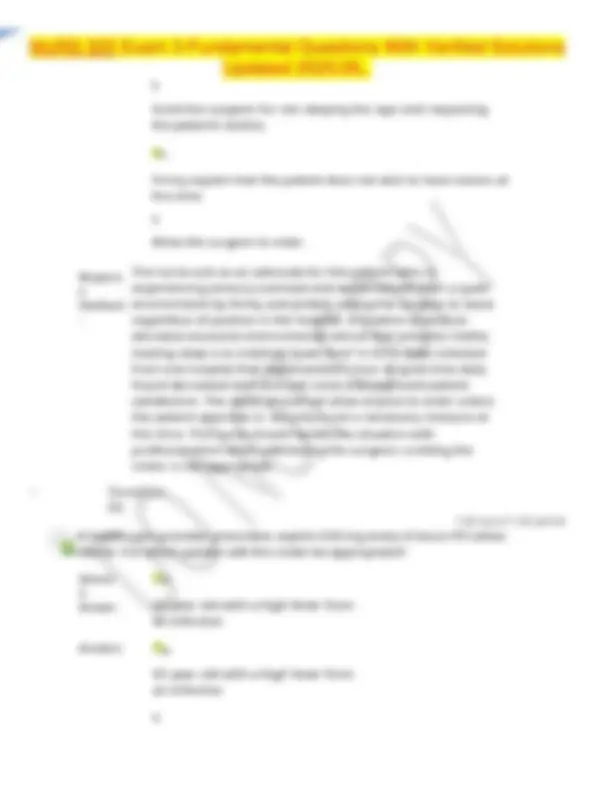

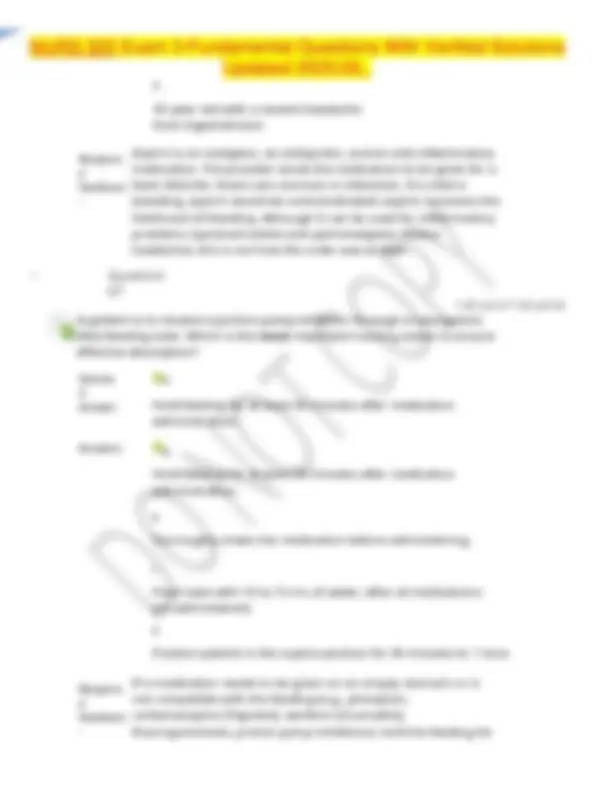



Study with the several resources on Docsity

Earn points by helping other students or get them with a premium plan


Prepare for your exams
Study with the several resources on Docsity

Earn points to download
Earn points by helping other students or get them with a premium plan
Community
Ask the community for help and clear up your study doubts
Discover the best universities in your country according to Docsity users
Free resources
Download our free guides on studying techniques, anxiety management strategies, and thesis advice from Docsity tutors
NURS 325 Exam 3-Fundamental Questions With Verified Solutions Updated 2025/26,.NURS 325 Exam 3-Fundamental Questions With Verified Solutions Updated 2025/26,.
Typology: Exams
1 / 105

This page cannot be seen from the preview
Don't miss anything!





























































































1.42 out of 1.42 points A nurse explains the function of the alveoli to a patient with respiratory problems. Which information about the alveoli’s function will the nurse share with the patient? Selecte d Answer: a. Carries out gas exchange Answers: (^) a. Carries out gas exchange b. Regulates tidal volume c. Stores oxygen Respons e Feedback : d. Produces hemoglobin The alveolus is a capillary membrane that allows gas exchange of oxygen and carbon dioxide during respiration. The alveoli do not store oxygen, regulate tidal volume, or produce hemoglobin.
1.42 out of 1.42 points A home care nurse is inspecting a patient’s house for safety issues. Which findings will cause the nurse to address the safety problems? ( Select all that apply .) Selected Answers : a. Stairway faintly lit
b. Scatter rugs in the kitchen c. Absence of smoke alarms
b. Oxygen cannula
c. Pulse oximeter Respons e Feedback : d. Yankauer suction tip catheter A blood pressure cuff is needed. The diastolic aortic pressure is a good clinical measure of afterload. Afterload is the resistance to left ventricular ejection. In hypertension the afterload increases, making cardiac workload also increase. A pulse oximeter is used to monitor the level of arterial oxygen saturation; it will not help determine increased afterload. While an oxygen cannula may be needed to help decrease the effects of increased afterload, it will not help determine the presence of afterload. A Yankauer suction tip catheter is used to suction the oral cavity.
1.42 out of 1.42 points The nurse enters the patient’s room and notices a small fire in the headlight above the patient’s bed. In which order will the nurse perform the steps, beginning with the first one?
Respons e Feedback :
Nurses use the mnemonic RACE to set priorities in case of fire. The steps are as follows: Rescue and remove all patients in immediate danger; Activate the alarm; Confine the fire by closing doors and windows; and Extinguish the fire using an appropriate extinguisher.
1.42 out of 1.42 points The nurse is admitting a patient with uncontrolled diabetes mellitus. It is the fourth time the patient is being admitted in the last 6 months for high blood sugars. During the admission process, the nurse asks the patient about employment status and displays a nonjudgmental attitude. What is the rationale for the nurse’s actions? Selecte d Answer: b. A person’s compliance is affected by economic status. Answers: a. Employment status is an internal variable that impacts compliance. b. A person’s compliance is affected by economic status. c. Noncompliant patients thrive on the disapproval of authority figures. Respons e Feedback : d. External variables have little effect on compliance. A person’s compliance with treatment is affected by economic status. A person tends to give a higher priority to food and shelter than to costly drugs or treatments. External variables can have a major impact on compliance. Employment status is an external variable, not an internal variable. A person generally seeks approval and support from social networks, and this
desi re for approval affects health beliefs and practices; noncompliance does not occur from thriving on disapproval of authority figures.
1.42 out of 1.42 points
r ate Answers: a. Increased blood sugar
b. Decreased heart rate c. Dilated pupils Respons e Feedback : d. Elevated blood pressure Decreased heart and respiratory rates, blood pressure, and oxygen consumption and increased alpha brain activity and peripheral skin temperature characterize the relaxation response. The physiological cascade of changes associated with the stress response includes increased heart and respiratory rates, muscle tightening, increased metabolic rate, a sense of foreboding, fear, nervousness, irritability, and a negative mood. Other physiological responses include elevated blood pressure; dilated pupils; stronger cardiac contractions; and increased levels of blood glucose, serum cholesterol, circulating free fatty acids, and triglycerides.
0 out of 1.42 points The patient had a colostomy placed 1 week ago. When approached by the nurse, the patient and spouse refuse to talk about it and refuse to be taught about how to care for it. How will the nurse evaluate this couple’s stage of adjustment? Selecte d Answer: (^) Shock Answers: (^) a. Withdrawal b. Rehabilitati on
Respons e Feedback : Acceptance As the patient and family recognize the reality of a change, they become anxious and may withdraw, refusing to discuss it. This is an adaptive coping mechanism that assists the patient in making the adjustment. Initially, the patient may be shocked by the change. This is followed by withdrawal, acknowledgment, acceptance, and rehabilitation (ready to adapt to the change through use of colostomy bag).
1.42 out of 1.42 points The supervising nurse is watching nurses prepare medications. Which action by one of the nurses will the supervising nurse stop immediately? Selecte d Answer: c. Prepares NPH insulin to be given intravenously (IV) Answers: a. Draws up glargine (Lantus) in a syringe by itself b. Rolls insulin vial between hands c. Prepares NPH insulin to be given intravenously (IV) Respons e Feedback : d. Administers a dose of correction insulin The only insulin that can be given IV is regular. NPH cannot be given IV and must be stopped. All the rest demonstrate correct practice. Insulin is supposed to be rolled, not shaken. Glargine is supposed to be given by itself; it cannot be mixed with another medication. Correction insulin, also known as sliding- scale insulin, provides a dose of insulin based on the patient’s blood glucose level. The term correction insulin is preferred
bec aus e it indicates that small doses of rapid- or short-acting insulins are needed to correct a patient’s elevated blood sugar.
1.42 out of 1.42 points
Cultural backgroun d e. Socioecon omic status
Answers: (^) a. Social support b. Cultural background c. Patient's perception of the illness d. Patient’s coping skills Respons e Feedback : e. Socioeconomic status External variables influencing a patient’s illness behavior include the visibility of symptoms, social group, cultural background, economic variables, accessibility of the health care system, and social support. Internal variables include the patient’s perceptions of symptoms and the nature of the illness, as well as the patient’s coping skills and locus of control.
Respons e Feedback :
[None Given]
1.42 out of 1.42 points The nurse administers a central nervous system stimulant to a patient. Which assessment finding indicates to the nurse that an idiosyncratic event is occurring? Selecte d Answer: c. Falls asleep during daily activities Answers: a. Develops restlessness b. Presents with a pruritic rash c. Falls asleep during daily activities Respons e Feedback : d. Experiences alertness An idiosyncratic event is a reaction opposite to what the effects of the medication normally are, or the patient overreacts or underreacts to the medication. Falls asleep is an opposite effect of what a central nervous system stimulant should do. A stimulant should make a patient restless and alert. A pruritic (itch) rash could indicate an allergic reaction.
1.42 out of 1.42 points The nurse is working in a drug rehabilitation clinic and is in the process of
admitting a patient for “detox.” What should the nurse do next? Selecte d Answer: d. Identify the patient’s stage of change. Answers: a.